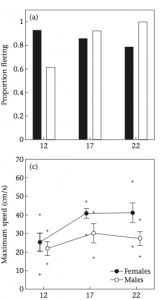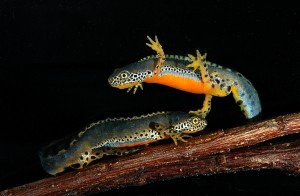The ability to effectively escape predators is an essential component of every organism’s behavioral repertoire. Responses to predator detection vary greatly between species, as well as within species, depending on various environmental factors. Recent research exploring these escape responses in the Alpine newt, or Ichthyosaura alpestris, has revealed that these behaviors may be modulated by environmental temperature as well as the sex of the newt, which can help us understand how environmental changes such as global warming may affect the behavior of certain species across the world.
Alpine newts are ectotherms, meaning that their body temperature is not internally moderated and is largely dependent on the environmental temperature. This means that the outside temperature can exert a significant influence on their ability to perform certain behaviors. In addition, there are significant physiological differences between male and female Alpine newts, which can further influence their behavioral responses.
The newts have two primary sets of defenses against predators, fleeing or secreting a toxic substance while remaining immobile. In this new study by Polcak and Gvozdik (2014), the researchers predicted that the newts would prefer to flee at higher temperatures, because previous research has indicated that lizard limb muscles may be more efficient at warmer temperatures. The researchers also expected that males would flee more frequently than females.
To test these hypotheses, newts were placed in a tank at either 12°C, 17°C, or 22°C while their tails were touched with the tip of a snake’s tongue several times, and fleeing or secretion behaviors were recorded. Interestingly, temperature appeared to have an effect only on the behavior of males, which fled more often at the higher temperatures, while the females fled at approximately the same rate every time. Females also fled at a significantly higher speed, which was unexpected. Finally, secretion behavior was unaffected by sex, but all of the newts required more encounters with the snake tongue in order to commence secretion at 17°C than at either the higher or lower temperatures.

Effects of temperature and sex on fleeing frequency and speed. In (a), females are represented by black bars, and males are represented by white bars. The x-axis values refer to degrees Celsius of the experimental setup. The graphs demonstrate that males fled more frequently at higher temperatures, while the females consistently fled faster than the males at all temperatures. (Source: Polcak & Gvozdik, 2014).
The interaction between these two factors is at first puzzling, but in fact there are several potential explanations. It is possible that the males and females differ in toxicity levels, so if females are less toxic, they may rely more on fleeing behavior regardless of temperature. This could also explain why females fled faster than males. Additionally, the difference in speed could be attributed to the fact that females encounter snakes more often due to sex differences in habitat choice. Finally, the reason that secretion behavior was only elicited after a higher number of tongue-touches at 17°C could potentially be because 17°C is the optimal temperature for other types of performance traits, such as fleeing. Since it requires a great deal of energy to produce toxins, it may be advantageous to delay secretion if another defense behavior will suffice.
In order to further clarify the mechanisms behind these findings, future studies should evaluate the difference in toxicity levels between males and females, and should also measure the relationship between the rate of snake encounters and the speed of fleeing behavior, as this study predicts that these might be positively correlated.
These results are very exciting, because they can help us to understand how ectotherms respond to environmental changes in temperature. This is a very important issue to consider in light of potential climate changes due to global warming, and can help us to understand how these changes might impact a large number of species across the planet.
For more information, see:
Polcak, D. & Gvozdik, L. (2014). Should I stay or should I go? The influence of temperature and sex on predator-induced responses in newts. Animal Behavior, 89, 79-84.

